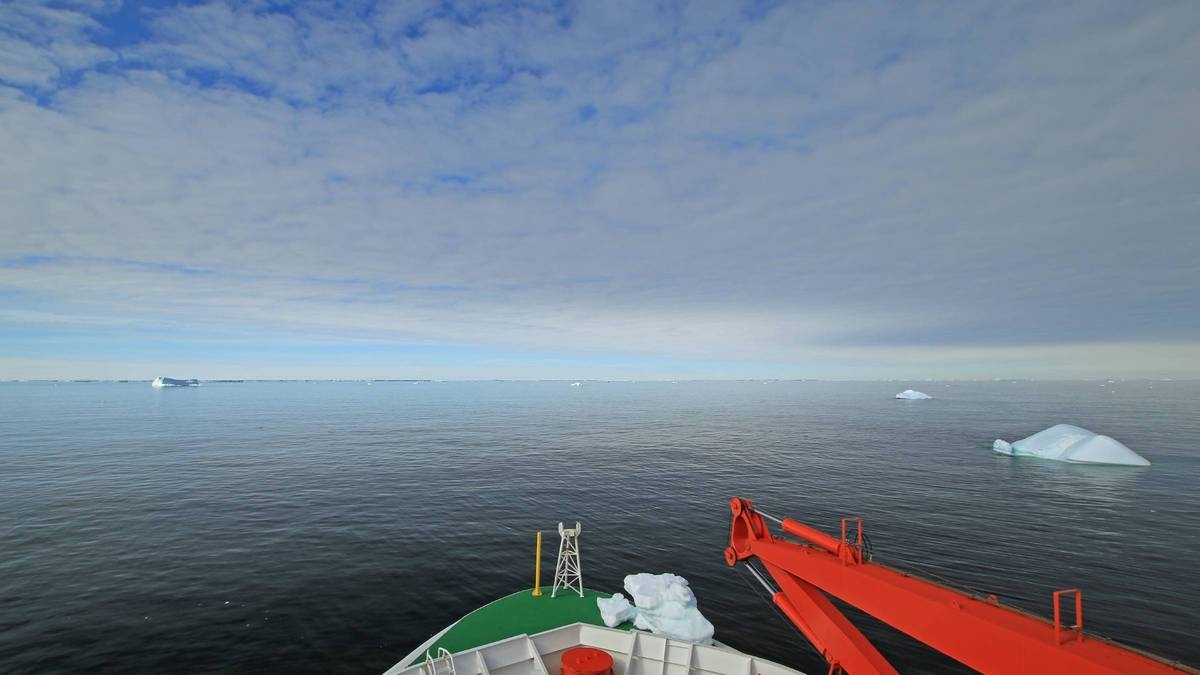We reach more than 65,000 registered users in Dec!! Register Now

Record low sea ice cover in the Antarctic
- February 16, 2023
- 22 Views
- 0 Likes
- 0 Comment
There is currently less sea ice in the Antarctic than at any time in the forty years since the beginning of satellite observation: in early February 2023, only 2.20 million squailometres of the Southern Ocean were covered with sea ice. Researchers from the Alfred Wegener Institute and the University of Bremen analyse the situation for the Sea Ice Portal. January 2023 had already set a new record for its monthly mean extent (3.22 million square kilometres), even though the melting phase in the Southern Hemisphere continues until the end of February. The current expedition team on board RV Polarstern has just reported virtually ice-free conditions in its current research area, the Bellingshausen Sea.Sea ice extent in the Southern Ocean now the lowest since the beginning of satellite observation forty years ago
“On 8 February 2023, at 2.20 million square kilometres, the Antarctic sea ice extent had already dropped below the previous record minimum from 2022 (2.27 million square kilometres on 24 February 2022). Since the sea ice melting in the Antarctic will most likely continue in the second half of the month, we can’t say yet when the record low will be reached or how much more sea ice will melt between now and then,” says Prof Christian Haas, Head of the Sea Ice Physics Section at the Alfred Wegener Institute, Helmholtz Centre for Polar and Marine Research (AWI), with regard to the current developments in the Antarctic. “The rapid decline in sea ice over the past six years is quite remarkable, since the ice cover hardly changed at all in the thirty-five years before. It is still unclear whether what we are seeing is the beginning of a rapid end to summer sea ice in the Antarctic, or if it is merely the beginning of a new phase characterised by low but still stable sea ice cover in the summer.”

In the course of the year, the Antarctic sea ice generally reaches its maximum extent in September or October and its minimum extent in February. In some regions, the sea ice melts completely in summer. In winter, the cold climate throughout the Antarctic promotes the rapid formation of new sea ice. At its maximum, the sea ice cover in the Antarctic is generally between 18 and 20 million square kilometres. In summer, it dwindles to roughly 3 million square kilometres, displaying far more natural annual variability than ice in the Arctic.
Further, Antarctic sea ice is much thinner than its Arctic counterpart and appears only seasonally – which explains why, for a very long time, its development was considered impossible to predict beyond a matter of days. In recent years, however, science has uncovered several mechanisms for predicting the development of sea ice on seasonal time scales. Knowing the sea ice presence weeks to months in advance is of great interest to Antarctic shipping.

https://www.awi.de/fileadmin/user_upload/AWI/Ueber_uns/Service/Presse/2023/1_Quartal/PM_ANT_Meereis/202301_Antarctic_animation_sea_ice_concentration_January_2023_meereisportal.mp4
Unravelling the geological evolution of the West Antarctic Ice Sheet, i.e., the massive glaciers that cover the Antarctic continent and fuel the ice shelves, is the proclaimed goal of the current Polarstern expedition. Doing so, it is hoped, will allow us to make more accurate statements on the ice sheet’s future development, and therefore on sea-level rise in the face of constant climate change. For example, the last interglacial, 120,000 years ago, and a prolonged warm period in the Pliocene roughly 3.5 million years ago, are considered analogous to today. In both past periods, the warming was exclusively due to gradual changes in Earth’s orbit – today, these are supplemented by carbon dioxide emissions, which are produced by the use of fossil fuels and accumulate in the atmosphere. The insights gleaned from the ice sheets’ history are intended to help estimate how rapidly and extensively they will melt when certain tipping points of today's rapid anthropogenic climate change are exceeded. In this regard, researchers use geophysical and geological methods to investigate marine sediments at the sea floor, which, as archives of past ice-sheet movements, hold valuable information.
Historical records also reflect the tremendous changes. For example, in the Antarctic summer 125 years ago, the Belgian research vessel Belgica was trapped in the massive pack ice for more than a year – in exactly the same region where the Polarstern can now operate in completely ice-free waters. The photographs and diaries of the Belgica’s crew offer a unique chronicle of the ice conditions in the Bellingshausen Sea at the dawn of the industrial age, which climate researchers often use as a benchmark for comparison with today’s climate change.
Cite This Article as
No tags found for this post









